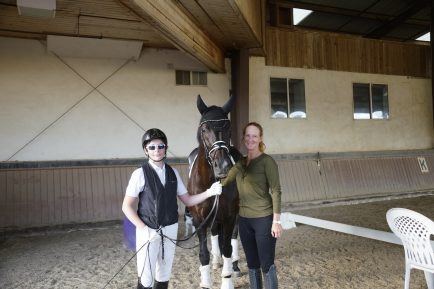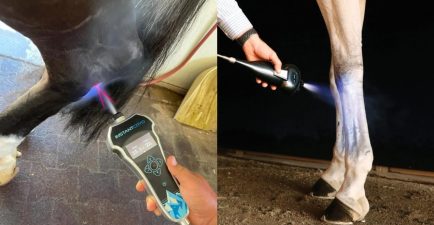- Horses Sleep Standing Up
:max_bytes(150000):strip_icc():format(webp)/three-horses-sleeping-in-sun-close-up-of-head-121806656-5739a4015f9b58723d5e9477.jpg) Daniel Valla Frps / Getty ImagesYes, horses can sleep standing up! They sleep laying down too. Learn all about the sleeping habits of horses. Horses must lie down to achieve a full restorative sleep cycle for a minimum of 30 minutes per day to avoid sleep deprivation. There are many factors that influence a horse’s ability to lay down to sleep and rest. These factors may be environmental such as weather, available space and comfortable bedding or physical deterrents such as musculoskeletal impediments; ie osteoarthritis.1
Daniel Valla Frps / Getty ImagesYes, horses can sleep standing up! They sleep laying down too. Learn all about the sleeping habits of horses. Horses must lie down to achieve a full restorative sleep cycle for a minimum of 30 minutes per day to avoid sleep deprivation. There are many factors that influence a horse’s ability to lay down to sleep and rest. These factors may be environmental such as weather, available space and comfortable bedding or physical deterrents such as musculoskeletal impediments; ie osteoarthritis.1 - 02of 15Horses Can’t Burp
:max_bytes(150000):strip_icc():format(webp)/horse-skeleton-artwork-173297787-57f26e5c3df78c690fe63af1.jpg) SCIEPRO / Getty ImagesThat’s right! Horses can’t burp, at least not the way humans do. They can’t vomit or breathe through their mouths like humans do either. A horse’s digestive system is a one-way street, unlike cattle and other ruminants who regurgitate food to re-chew it. Although they have a pretty efficient way of processing the tough fibrous foods that make up their forage, this long, one-directional system can cause problems that result in colic.2
SCIEPRO / Getty ImagesThat’s right! Horses can’t burp, at least not the way humans do. They can’t vomit or breathe through their mouths like humans do either. A horse’s digestive system is a one-way street, unlike cattle and other ruminants who regurgitate food to re-chew it. Although they have a pretty efficient way of processing the tough fibrous foods that make up their forage, this long, one-directional system can cause problems that result in colic.2 - 03of 15You Can Estimate a Horse’s Age by Its Teeth
:max_bytes(150000):strip_icc():format(webp)/angry-horse-on-field-524239769-57f26ed15f9b586c354d6642.jpg) Kat Fo / EyeEm / Getty ImagesWhile you can’t tell the exact age of a horse by its teeth, you can estimate its age. Horses need proper equine dental care for their teeth, but sometimes a horse lives longer than its teeth do, so extra care is needed when feeding senior horses.
Kat Fo / EyeEm / Getty ImagesWhile you can’t tell the exact age of a horse by its teeth, you can estimate its age. Horses need proper equine dental care for their teeth, but sometimes a horse lives longer than its teeth do, so extra care is needed when feeding senior horses. - 04of 15Horses Can Live to Be More Than 30 Years Old
:max_bytes(150000):strip_icc():format(webp)/a-horse-80470906-57f26f5f5f9b586c354d68e6.jpg) Image Source / Getty ImagesOne of the most common questions about horses is “how long does a horse live?” The answer may surprise you. Knowledge of horse nutrition, horse care, and veterinary medicine has increased. Because of this, just as human life expectancy has increased, so has equine longevity.
Image Source / Getty ImagesOne of the most common questions about horses is “how long does a horse live?” The answer may surprise you. Knowledge of horse nutrition, horse care, and veterinary medicine has increased. Because of this, just as human life expectancy has increased, so has equine longevity. - 05of 15The American Quarter Horse Is the World’s Most Popular Breed
:max_bytes(150000):strip_icc():format(webp)/quarter-horse-582671304-57f270293df78c690fe64ba4.jpg) Kit Houghton / Getty ImagesAppreciated by beginner riders and professional horsemen alike, the American quarter horse is the world’s most popular breed. Learn more about the American quarter horse.
Kit Houghton / Getty ImagesAppreciated by beginner riders and professional horsemen alike, the American quarter horse is the world’s most popular breed. Learn more about the American quarter horse. - 06of 15(Most) Arabian Horses Have One Less Vertebrae Than Other Breeds
:max_bytes(150000):strip_icc():format(webp)/nativearabianhorselg-56a4db743df78cf77284fae3.jpg) Christof Koepsel / Getty ImagesThe Arabian horse is the foundation of many other light horse breeds. They also possess some unique characteristics. Most Arabian horses have one fewer vertebrae, rib bone, and tail bone than other horses.
Christof Koepsel / Getty ImagesThe Arabian horse is the foundation of many other light horse breeds. They also possess some unique characteristics. Most Arabian horses have one fewer vertebrae, rib bone, and tail bone than other horses. - 07of 15Horses Are Herbivores
:max_bytes(150000):strip_icc():format(webp)/canada-british-columbia-tweedsmuir-park-chilcotin-region-chilcotin-ark-rainbow-mountains-horses-trail-horses-602194837-57f273b73df78c690fe683a2.jpg) Chris Harris / Getty ImagesHumans are omnivores, lions are carnivores, and horses are herbivores. The way their teeth are formed (grinding molars to break down fibrous plant material), the position of their eyes (face to the side to be on the lookout for predators), and the type of digestive system are all typical characteristics of herbivores.
Chris Harris / Getty ImagesHumans are omnivores, lions are carnivores, and horses are herbivores. The way their teeth are formed (grinding molars to break down fibrous plant material), the position of their eyes (face to the side to be on the lookout for predators), and the type of digestive system are all typical characteristics of herbivores. - 08of 15Horses Are Herd Animals
:max_bytes(150000):strip_icc():format(webp)/group-of-horses-528902971-57f274b73df78c690fe68cc4.jpg) Arctic-Images / Getty ImagesHorses in the wild live in small herds, and domestic horses feel more comfortable if they have companions too. It can be quite stressful for a horse to live alone.3 Companionship for horses may be an equine stablemate or even another species such as a goat, donkey, or mule. Even a dog may become a suitable companion for a horse.
Arctic-Images / Getty ImagesHorses in the wild live in small herds, and domestic horses feel more comfortable if they have companions too. It can be quite stressful for a horse to live alone.3 Companionship for horses may be an equine stablemate or even another species such as a goat, donkey, or mule. Even a dog may become a suitable companion for a horse. - 09of 15Horses Were Domesticated by Humans More Than 3,000 Years Ago
:max_bytes(150000):strip_icc():format(webp)/relief-depicting-preparation-of-chariot-mortuary-temple-of-ramesses-iii-medinet-habu-thebes-unesco-world-heritage-list-1979-egyptian-civilization-new-kingdom-dynasty-xx-621713323-57f273cf3df78c690fe683a4.jpg) De Agostini / C. Sappa / Getty ImagesDogs may have become domesticated around 14,000 years ago. Cats became human companions about 8,500 years ago. Humankind’s relationship with the horse began a little more recently, around 6,000 years ago, although some evidence has come to light that horses may have been domesticated even earlier.
De Agostini / C. Sappa / Getty ImagesDogs may have become domesticated around 14,000 years ago. Cats became human companions about 8,500 years ago. Humankind’s relationship with the horse began a little more recently, around 6,000 years ago, although some evidence has come to light that horses may have been domesticated even earlier. - 10of 15Horses Are Measured in “Hands”
:max_bytes(150000):strip_icc():format(webp)/a-woman-and-a-girl-measuring-height-of-pony-using-measuring-stick-against-withers-151324876-57f273db5f9b586c354dac0d.jpg) Bob Langrish / Getty ImagesThe standard measurement for determining the height of a horse is called a hand. One hand is equal to 4 inches. A pony is an equine under 14.2 hands. The only equines not measured in hands are miniature horses, which are measured in inches or centimeters.
Bob Langrish / Getty ImagesThe standard measurement for determining the height of a horse is called a hand. One hand is equal to 4 inches. A pony is an equine under 14.2 hands. The only equines not measured in hands are miniature horses, which are measured in inches or centimeters. - 11of 15Most White Horses Are Actually Gray
:max_bytes(150000):strip_icc():format(webp)/two-wild-horses-equus-caballus-on-coastal-headland-200497014-001-57f2729b3df78c690fe67b1c.jpg) Steve Coleman / Getty ImagesMost of the white horses that you see were actually a much darker color at birth and gradually turn white. These “white” horses may start as bay, chestnut, or almost black. These horses aren’t called white, but gray.
Steve Coleman / Getty ImagesMost of the white horses that you see were actually a much darker color at birth and gradually turn white. These “white” horses may start as bay, chestnut, or almost black. These horses aren’t called white, but gray. - 12of 15A Horse’s Resting Respiratory Rate Is About 8-14 Breaths per Minute
:max_bytes(150000):strip_icc():format(webp)/veterinarian-examining-the-horse-154954814-5755c2a93df78c9b4690238a.jpg) Alina Solovyova-Vincent / Getty ImagesIt’s important to know the resting pulse and respiration rate of your horse. While the resting respiration rate of a horse can be as low as eight breaths per minute, that can quickly increase with work or distress.4 Learn your horse’s resting pulse and respiration rate (TPR).
Alina Solovyova-Vincent / Getty ImagesIt’s important to know the resting pulse and respiration rate of your horse. While the resting respiration rate of a horse can be as low as eight breaths per minute, that can quickly increase with work or distress.4 Learn your horse’s resting pulse and respiration rate (TPR). - 13of 15Horses Are Not Native to North America
:max_bytes(150000):strip_icc():format(webp)/rock-painting-of-tarpans-ponies-c-17000-bc-56258005-57f271815f9b586c354d9369.jpg) Paleolithic / Getty ImagesEvery horse on the North American continent is a decedent of European horses. Even the horses that we regard as “wild” are actually feral horses, whose ancestors escaped from captivity. Horses disappeared from the Americas more than 11,000 years ago, and there is ample fossil evidence that the horse’s ancestors lived here previous to that.
Paleolithic / Getty ImagesEvery horse on the North American continent is a decedent of European horses. Even the horses that we regard as “wild” are actually feral horses, whose ancestors escaped from captivity. Horses disappeared from the Americas more than 11,000 years ago, and there is ample fossil evidence that the horse’s ancestors lived here previous to that. - 14of 15A Baby Horse is Called a Foal
:max_bytes(150000):strip_icc():format(webp)/foalnursing-56a4dbf83df78cf77284feb0.jpg) ElaiEva / www.freeimages.com/What is the difference between a filly, a colt, and a foal? It all depends on gender and age. Generally, a foal is a baby horse. After it is weaned from its dam, it is called a weanling. But, horses remain fillies or colts until they are four years of age.
ElaiEva / www.freeimages.com/What is the difference between a filly, a colt, and a foal? It all depends on gender and age. Generally, a foal is a baby horse. After it is weaned from its dam, it is called a weanling. But, horses remain fillies or colts until they are four years of age. - 15of 15The Original “Horse” Was the Size of a Golden Retriever
:max_bytes(150000):strip_icc():format(webp)/close-up-of-a-phorusrhacos-phorusrhacos-longissimus-chasing-eohippuses-73685827-57f271425f9b586c354d8ed3.jpg) DEA PICTURE LIBRARY / Getty ImagesThe original horse was no larger than a golden retriever. Diminutive Hyracotherium may have looked more like a small goat or deer than a modern-day horse. Hyracotherium lived during the Eocene Epoch about 50 million years ago.
DEA PICTURE LIBRARY / Getty ImagesThe original horse was no larger than a golden retriever. Diminutive Hyracotherium may have looked more like a small goat or deer than a modern-day horse. Hyracotherium lived during the Eocene Epoch about 50 million years ago.
Original article: 15 Interesting Horse Facts (thesprucepets.com)

























